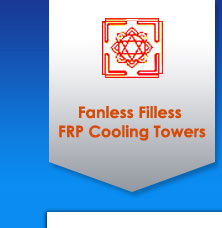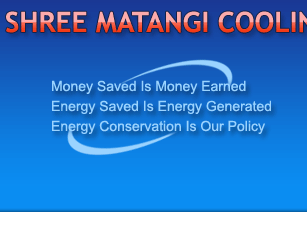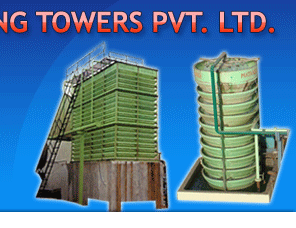 |
 |
| SHREE MATANGI COOLING TOWERS PVT LTD |
| |
This is an equipment to lower the temperature of liquid (usually water) with the help of atmospheric air. The process is evaporation; atmospheric air is normally not saturated with water, and has affinity to absorb additional moisture, till it becomes saturated. This process of absorption is improved by breaking water into small droplets thus evaporation is increased.
The energy required to evaporate water is taken by fall in temperature of the remaining water. For each kg of water evaporated about 550 k. cal. of heat energy is available for cooling the remaining water, and heat the air.
This is what is happening in the tower.
In industry, cool water is used in the process for removal of heat. This water becomes hot. It is cooled in cooling tower and reused.
To design a cooling tower, the water flow rate, water inlet temperature, water outlet temperature, wet bulb temperature etc are required |
| |
|
|
|
|
| |
| Definitions: |
 |
 |
| Humidity: |
 |
| It is the condition of atmosphere. It is defined as numbers of kg of water carried by 1 kg of dry air. |
| |
| Wet Bulb Temperature: |
 |
| It is equilibrium temperature attained by a water surface when exposed to air in a manner such that the sensible heat transferred from air to the water is equal to the latent heat carried away by evaporation of water into the air |
| |
| Approach: |
 |
| It is the condition of cooling tower. It specifies the cooled water temperature with reference to wet bulb temp. It is the difference between cooled water temperature and wet bulb temperature. |
| |
| Range: |
 |
| It is the condition of cooling tower. It indicates cooled water temperature with reference to hot water temperature. It is the difference between hot water temperature and cooled water temperature. |
| |
| CLASSIFICATION OF COOLING TOWER |
 |
| To make cooling tower more efficient air draft has to be created. The method used to create this air draft classifies the type of cooling tower as given below. |
| |
|
| A. Natural Draft Cooling Tower |
 |
| In a Natural Draft Cooling Tower hot water is allowed to pour from top of cooling tower through a distributing system. As water begins downward flow, it is broken up and redistributed by screen / fills. Atmospheric air, which enters the cooling tower horizontally, will come in contact with water and cooling process take place. The quantity of air entering cooling tower will depend on atmospheric wind velocity. This will vary as per the local site conditions like wind velocity, temperature conditions etc and hence, performance of cooling tower will vary accordingly. |
| |
|
| TOP |
| B. Air Draft Cooling Tower |
 |
| Because of varying, unreliable, and uncontrollable performance of natural draft cooling tower the system was devised to pass air at desired controlled rate. This is the air draft. This air draft is created by mechanical means. Therefore they are mechanical-draft cooling tower. |
| TOP |
| a. Forced Draft Cooling Tower |
 |
| This is counter flow cooling tower. Hot water is sprayed at the top of the cooling tower and air is travelling from bottom to top in opposite direction of water. In forced draft cooling tower air is pushed inside the cooling tower at the bottom of cooling tower and then air goes up and comes in contact with down coming water. |
| |
|
|
| TOP |
| b. Induced Draft Cooling Tower |
 |
| 1. Fan Operated Induced Draft Cooling Tower |
 |
| This is counter flow cooling tower in which hot water is sprayed at the top of cooling tower and air travels from bottom to top in opposite direction of water. In induced draft cooling tower fan is provided at the top and air is induced from the bottom side |
| |
|
| TOP |
| 2. FANLESS Induced Draft Cooling Tower |
 |
This is co-current cooling tower. Air and water both travel together in the same direction from top to bottom. Hot water is allowed to spray through specially designed nylon/pp nozzles at minimum 0.5 kg./ sq. cm pressure. Water enters nozzle tangentially at top and is given spiral action in spiral chamber. This spiral action increases as water approaches the discharge orifice and comes out centrally from discharge orifice with fine droplets in umbrella shape. Air around the nozzle is sucked because of air displacement at a lower level near discharge orifice and fresh dry air takes its place.
This assures better contact of air and water and the high cooling efficiency. |
| |
|
| TOP |
| |



